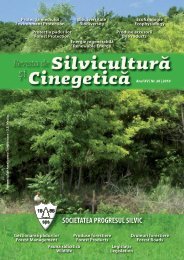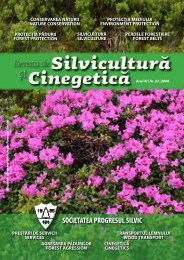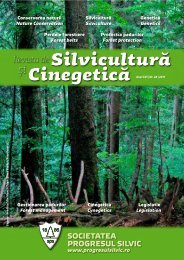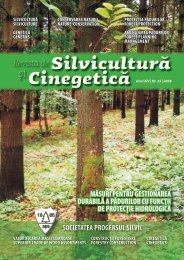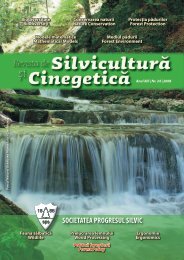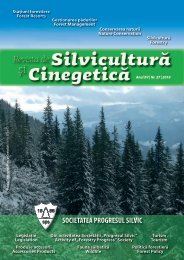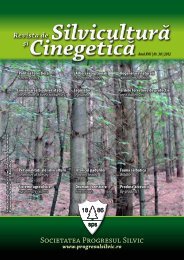Silviculture and Cinegetics Review - Societatea Progresul Silvic
Silviculture and Cinegetics Review - Societatea Progresul Silvic
Silviculture and Cinegetics Review - Societatea Progresul Silvic
You also want an ePaper? Increase the reach of your titles
YUMPU automatically turns print PDFs into web optimized ePapers that Google loves.
FORESTRY BELTS SILVICULTURE AND CINEGETICS REVIEW XVII/30/2012<br />
products <strong>and</strong> accessories; vi) increasing the surface<br />
area covered by forest; vii) economic <strong>and</strong> social<br />
protecting objectives <strong>and</strong> ways of communication<br />
(forest belts prevent the heavy snow falls by<br />
accumulation of snow in <strong>and</strong> near them); viii) creating<br />
favorable conditions for development of wildlife; ix)<br />
enhancing regional biodiversity; x) improving carbon<br />
stock; xi) conserving energy; xii) rebuilding <strong>and</strong><br />
improving l<strong>and</strong>scape.<br />
To achieve protection forest belts in order to result in<br />
a stable <strong>and</strong> sustainable agroforestry system there are<br />
some technical elements to be observed. Thus, the<br />
distance between forest belts should be 35 times the<br />
maximum height of tree species, averaging from 150<br />
to 150 m if necessary. For the effect of protection<br />
forest belts to be maximized it will be placed<br />
perpendicular to the main damaging winds. Protection<br />
forest belts width varies from 5-7 rows, when placed<br />
to improve microclimatic conditions, 7-8 (10) rows in<br />
areas with strong <strong>and</strong> dry winds, 4-5 lines in areas<br />
with less strong winds which have the role of snow<br />
accumulation <strong>and</strong> distribution (Lupe, 1952). Planting<br />
distance between rows of trees will be on average 2<br />
m, <strong>and</strong> between trees on the line will be 1 m. For<br />
maximum efficiency of the forest belt, its<br />
uninterrupted length should exceed the height, the<br />
ratio being at least 10: 1. In this way the influence of<br />
turbulence on its end it's reduced. Its continuity also<br />
influences the degree to which it shall function.<br />
Species that make up forest belts must meet at least<br />
three conditions, namely: i) should be resistant to<br />
adverse stationary conditions (climate, soil, <strong>and</strong><br />
groundwater); ii) should have high growth; iii) should<br />
ensure longevity of protection forest belt. For higher<br />
ameliorative effect, forest belts are composed of<br />
several species of trees <strong>and</strong> shrubs, arranged in a<br />
specific order to be as resistant as possible to various<br />
pests agents (wind, heat <strong>and</strong> / or excessive cold, etc.)<br />
<strong>and</strong> produce as many resources (wood <strong>and</strong><br />
accessories).<br />
Species of trees that make up a protection forest belt<br />
may be: i) main or basic species, trees that can reach<br />
large heights <strong>and</strong> diameters such as species of oak,<br />
black locust, honey locust, ash, elm, poplar, etc.; ii)<br />
secondary or help species, having a smaller size than<br />
the basic ones such as maple, field maple, lime, pear,<br />
flowering ash, Turkish cherry, etc.; iii) shrubs, small<br />
wood species, used for shading <strong>and</strong> soil protection,<br />
protection against the wind, soil improvement through<br />
litter they give, such as privet, hawthorn, blackthorn,<br />
oleaster, red dogwood, wild rose, smoke tree pea-tree,<br />
five stamen tamarisk etc.<br />
Although the main role of forest belts is the protection<br />
of crops, the resulting agroforestry system presents<br />
some important economic benefits, such as: i)<br />
increasing agricultural production <strong>and</strong> improving its<br />
quality; ii) diversification of production on the same<br />
l<strong>and</strong> area <strong>and</strong> therefore income diversification, which<br />
may originate from both crops <strong>and</strong> from the forest; iii)<br />
ensuring the sustainability of agricultural systems, by<br />
creating stable cultures in time <strong>and</strong> avoiding any loss<br />
of production.<br />
3.4. Water courses protection forest belts<br />
Water courses, lakes <strong>and</strong> ponds protection forest<br />
belts, are strips of trees of certain widths, which are<br />
planted between agricultural fields, pastures <strong>and</strong> water<br />
surface, or between existing levees along watercourses<br />
<strong>and</strong> surface for water quality protection, for the<br />
stabilization of banks <strong>and</strong> for flood prevention or<br />
mitigation, for improving the quality of agricultural<br />
l<strong>and</strong> <strong>and</strong> adjacent pastures (Fig. 5).<br />
In general, concerns about water protection forest<br />
belts were entered in the general issues related to<br />
forest belts. But watercourses forest belts protection<br />
have some characteristic features that distinguish them<br />
from other groups of forest belts, namely: i)<br />
watercourses protection forest belts extend over tens<br />
or even hundreds of kilometers, crossing <strong>and</strong> thus<br />
serving much larger areas than field protection forest<br />
belts; ii) width of these forest belts is usually much<br />
greater than the field protection forest belts; it can<br />
vary between 30 <strong>and</strong> 300 m <strong>and</strong> can be made from one<br />
or more b<strong>and</strong>s, up to 100 m wide, alternating with<br />
open corridors (Ionescu et al. 1960).<br />
Fig. 5. Watercourses <strong>and</strong> field protection forest belts<br />
(Bentrup, 2008)<br />
67



